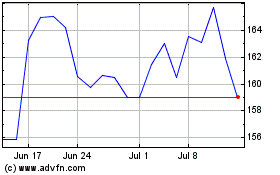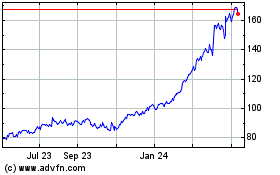By Thomas Gryta
This article is being republished as part of our daily
reproduction of WSJ.com articles that also appeared in the U.S.
print edition of The Wall Street Journal (July 18, 2018).
General Electric Co. has assured investors that its long-awaited
reorganization sets the company on a path to recovery, but some on
Wall Street still worry its biggest problem, GE Capital, will
continue to get in the way.
GE Capital wasn't central to the plans Chief Executive John
Flannery unveiled last month to restructure the company around its
power and aviation businesses. The lending unit, which once
financed things including oil-drilling ships and overseas car
loans, previously accounted for as much as half of GE's profit and
helped fund its dividend. Then the financial crisis hit, and GE
Capital nearly sank the entire company.
Former CEO Jeff Immelt sold most of the assets late in his
career, but some of the less-desired pieces continue to be a drag,
including a $15 billion commitment to an insurance business that
caught even board members and senior executives by surprise.
In mapping out GE's future structure, Mr. Flannery and his team
also grappled with what to do with GE Capital. The company
continues to work with bankers and advisers to shed pieces of the
business, devise a way to reduce or neutralize remaining risk, or,
ideally, separate the entire operation, according to people close
to the process.
GE said last month that it expects to put $3 billion in cash
into GE Capital in 2019, although several analysts warn that the
size of that contribution could grow.
"They've taken great pains in exiting a lot of GE Capital and
de-risking, " said Stifel analyst Robert McCarthy. "That said, we
continue to get nasty surprises."
As investors consider the risk and reward around GE shares,
which are down almost 50% in the past year, it is difficult to be
comfortable with the shadow of GE Capital and the potential for new
large financial obligations, Mr. McCarthy said. GE could face more
questions about its plans for the finance unit when the company
reports earnings on Friday morning.
Despite years of shrinking, GE Capital still has about $146
billion in assets, including a large airplane-leasing business, a
defunct subprime mortgage operation and more than $3 billion in a
collection of variable-rate Polish residential mortgages.
The size of the liabilities and uncertainty around some pieces
means that GE might have to pay someone to shed the business.
Mr. Flannery asserts that he is now comfortable that there are
no more looming surprises akin to the insurance shortfall,
prompting JPMorgan analyst Steve Tusa, a longtime bear on GE's
stock, to question the idea of paying money to eliminate
liabilities if there aren't further risks.
"They are working on ringfencing insurance, but we don't
understand why this is necessary if appropriately capitalized," he
wrote to investors recently. "A resolution of a neutral item that
requires cash or value transfer is negative."
GE Capital was launched last century to help consumers pay for
appliances. Former Chief Executive Jack Welch led its growth, and
assets had ballooned to $661 billion when credit markets seized up
during the financial crisis in late 2008.
GE is now essentially unwinding much of the entire operation,
with plans to sell $25 billion in energy and industrial finance
assets by 2020.
The potential separation of GE Capital is complicated by talks
with the Justice Department to settle claims the GE unit violated
the law with some of its lending practices leading up to the
financial crisis.
In a separation, GE's industrial divisions likely would add a
financial-services function, a tool that can be helpful in closing
sales of their massive machines that can cost hundreds of millions
of dollars. Competitors such as Siemens AG and United Technologies
Corp. have financial-services organizations that play that
role.
While the finance function is helpful, similar to getting a loan
from a car dealer, customers aren't necessarily getting better
terms than they would from a third-party institution, one
industrial executive said. But bundling the lending in-house gives
buyers the impression they are getting a good deal, the person
said.
The other significant pieces in GE Capital are its insurance
obligations and its airplane-leasing business. Mr. Flannery has
made it clear that he is looking at all options to neutralize the
insurance obligations, and executives have long referred to the
plane-leasing business, known as GE Capital Aviation Services, as a
"jewel" that could easily be sold.
The plane-leasing business owns almost 2,000 aircraft and leases
them to airlines, cargo companies and others, and is known on Wall
Street for its expertise in managing the life of an airplane. The
business has about $41 billion in assets, according to Moody's, and
it accounted for more than half of GE Capital's $9.1 billion in
revenue last year.
Mr. Flannery has said there are no "sacred cows" in his
restructuring of GE; he already has announced plans to shed the
health-care business he ran until last year.
"It has significant value. We're approached on that business all
the time," he said about the plane-leasing business in June. He
added that the $3 billion cash injection into GE Capital next year
will address the needed capital levels in the operation.
"But the big picture strategy is continue to shrink," he
said.
--Ted Mann contributed to this article.
Write to Thomas Gryta at thomas.gryta@wsj.com
(END) Dow Jones Newswires
July 18, 2018 02:47 ET (06:47 GMT)
Copyright (c) 2018 Dow Jones & Company, Inc.
GE Aerospace (NYSE:GE)
Historical Stock Chart
From Mar 2024 to Apr 2024

GE Aerospace (NYSE:GE)
Historical Stock Chart
From Apr 2023 to Apr 2024
